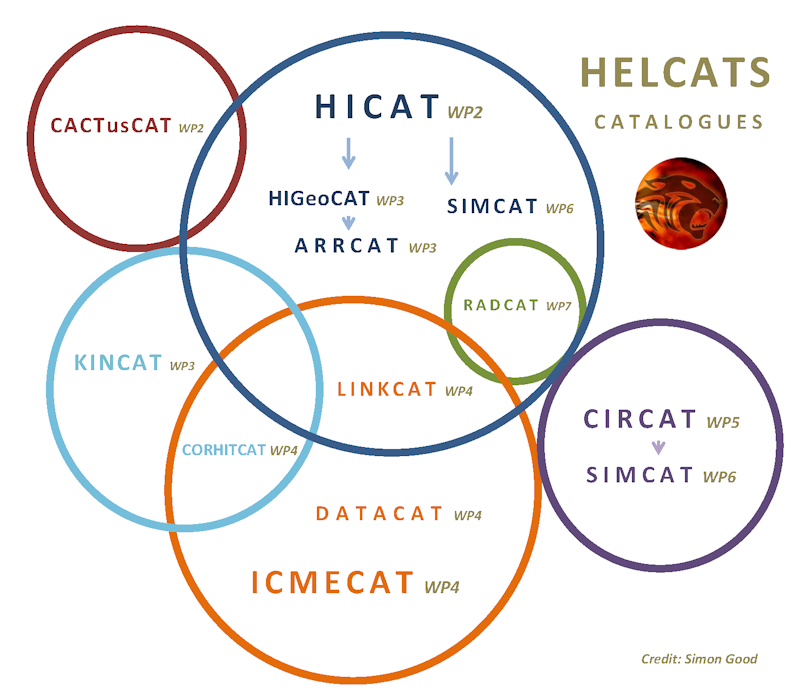 HELCATS Products
HELCATS Products
A full list of the formal deliverables to the EU are listed on the deliverables page and consists of a mixture of documentation, reports and data products. On this page we focus on the catalogue data products which will be the key outputs of interest to the science community and space weather activities.

HICAT
The first definitive catalogue of CMEs in the heliosphere from outside the Sun-Earth line.
The foundation of the project is the manual inspection and analysis of the STEREO/HI data to identify
and catalogue all CMEs in the heliosphere from April 2007 to February 2017 (Version 4, released 2017-04-06).
This is the HICAT catalogue, currently with 1,601 entries. Once identified, events are labelled with a
unique ID, and the date, time, spacecraft, CME position angles and event quality are listed.
Note that this has become the official and definitive event list of the STEREO/HI instruments
and, as such, the lists will be maintained by the STEREO project after the completion of the
HELCATS project.
HIGeoCAT
Extends the HICAT catalogue through the addition of kinematic parameters from geometrical modelling.
HIGeoCAT takes all of the HICAT CMEs for which geomagnetic modelling can be employed, to derive and
list kinematic parameters, such as speed and 3D direction, projected onset times. Later work, using
the in-situ observations of CME arrivals at Earth, is used to validate the models.
The HIGeoCAT catalogue is also in version 4, released on 2017-04-06, and it contains 1,414 CMEs.
In a sense, the production of the HIGeoCAT catalogue provides for the heliospheric community what
the CDAW catalogue has provided for the coronal community; this is a resource that will be used
extensively and is endorsed by the STEREO team.
CACTusCAT
Provides a list of automated CME detections for comparison with the manual HICAT and HIGeoCAT catalogues.
Exploiting and developing the CACTus method that has long been employed on the SOHO/LASCO coronal CME
data for automated CME detection, WP3 of HELCATS has demonstrated a capability for automated CME
detection in HI data and favourable comparisons made with the manual methods.
The current release runs from January 2007 to August 2014.
KINCAT
Catalogue of coronagraph observations using the GCS model. This catalogue aims to allow a comparison
of the HI-derived CME parameters of the HICAT and HIGeoCAT catalogues with an associated catalogue of
coronal CME parameters. Events are identified using the STEREO/COR2 observations (1071 events in all)
and the CME parameters (speed, direction, mass) derived from the application of a Graduated Cylindrical
Shell model (that assumes a flux-rope topology). Some 109 events are catalogued May 2007 to December 2011
for which the GCS model could be employed. This event-set is used to make a thorough assessment of the
relationship between events seen in the corona and in the heliosphere.
ARRCAT
Catalogue of CME predicted arrivals. This catalogue uses the Self Similar Expansion model (see WP3 and
4 sections of the report) to list the predicted arrival times of CMEs at Earth/L1, STEREO-A, STEREO-B,
Venus, MESSENGER, Mars, Saturn, Ulysses, Mars Science Laboratory (MSL), MAVEN and Rosetta. Of the
1330 CMEs in HICAT v3, ARRCAT lists some 1959 possible impacts on these targets. It is these impacts
and their timings that are used later to compare with and validate the heliospheric CME models.
ICMECAT
A catalogue of in-situ CME observations. Following on from the HIGeoCAT and subsequent ARRCAT catalogues,
the in-situ identification of CMEs at Earth/L1, STEREO-A, STEREO-B, Venus, MESSENGER, Mars, Saturn,
Ulysses, Mars Science Laboratory (MSL), MAVEN and Rosetta is given in the ICMECAT catalogue.
Comparison to HICAT v3, ICMECAT lists 556 in-situ CMEs - 407 at ~1 AU and 149 in the inner
heliosphere (Venus and MESSENGER). For all of these CMEs, parameters such as the mean magnetic field
and minimum Bz component have been derived, to aid comparisons to the predicted CME arrivals.
LINKCAT
Linking the solar, heliospheric and in-situ events. The LINKCAT catalogue is the glue between the coronal,
heliospheric and in-situ catalogues, connecting the events that are spatially and temporally consistent.
LINKCAT v1 (released 2016-07-11) includes some 143 entries, identifying the potential solar source
associated activity and the parameters of the potentially associated event arrivals with each HIGeoCAT
event for which such associations could be found (remembering that many of the HIGeoCAT events do not
impact the spacecraft being used (near-Earth or at Mars, Venus or elsewhere). With LINKCAT, we have
the first catalogue of CMEs linking from in-situ observations, through the heliosphere, the corona,
and to the solar source regions. Again, linking these datasets allows a thorough test of the modelling
employed in the analyses, projected to 1 AU and back-projected to the Sun.
CIRCAT
Catalogue of co-rotating/stream interaction regions. CIRs/SIRs can be detected in the HI data through
the passage of blob-like structures entrained in the interface regions. Given the experience with the
CME observations within the HELCATS project, it was logical to perform a parallel study of CIR/SIRs.
CIRCAT (version 2, released in 2017-03-27) provides a catalogue of the parameters of 212 events from
April 2007 to August 2014. This is the first such analysis and catalogue of its kind and, as with the
HI CME catalogue (HICAT/HIGeoCAT) is providing the first benchmark for studies of the phenomenon.
SIMCAT
Simulating the background solar wind. Recognising the extensive use of background solar wind simulations
for space weather application, especially through the Enlil-WSA model, the HELCATS project, through WP6,
attempts to simulate the background solar wind structure for advanced numerical modelling based on the
kinetic properties of the CMEs and CIRs/SIRs observed and analysed through the use of HI data, rather
than projected from solar magnetogram data using the so-called WSA empirical model. The simulated maps
appear in the SIMCAT catalogue and it is through that catalogue that their value is assessed in
comparison to the established methods.
RADCAT
Cataloguing radio Type II signatures associated with CMEs. As a speculative element to the HELCATS project,
two catalogues of radio phenomena have been produced. The RADCAT listing, provides a set of Type II radio
events in the period March 2008 to August 2014 (March 008 was the first event recorded; the analysis
extended to earlier dates). These are Type II data recorded by the S/WAVES instrument on STEREO, in the
frequency range 100 to 2000 kHz, which means that they are both coronal and heliospheric in nature and
could, thus be readily associated with the HI CMEs (ground based Type II observatories cannot extend to
such wavelengths and are generally only able to detect CMEs in the outer corona). RADCAT v3 lists parameters
for 156 entries. The focus of HELCATS was mainly on the visible-light and in-situ observations; the radio
was included as a pilot study to allow an initial comparison to the HICAT/HIGeoCAT events and to demonstrate
methods for detailed comparisons.
HELCATS IPS
Catalogue of IPS events. This catalogue exploits the interplanetary scintillation (IPS) radio observations
of the European EISCAT and LOFAR facilities in the detection of signatures of CMEs. Again, it is a speculative
pilot study aimed at identifying potential IPS events and comparing these to the HICAT/HIGeoCAT events to
assess how well IPS techniques might work (see WP7 section for details).
 HELCATS Products
HELCATS Products


